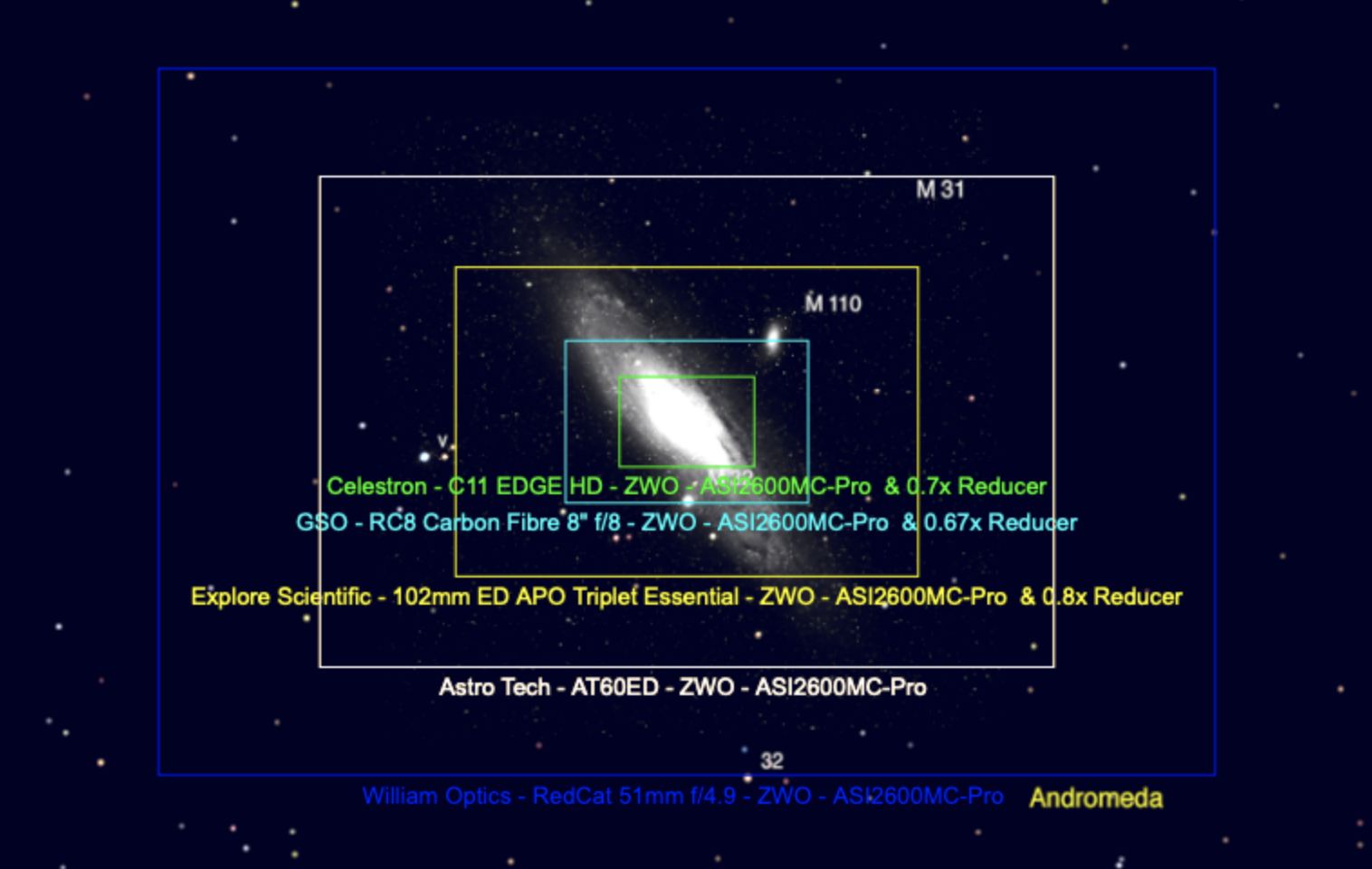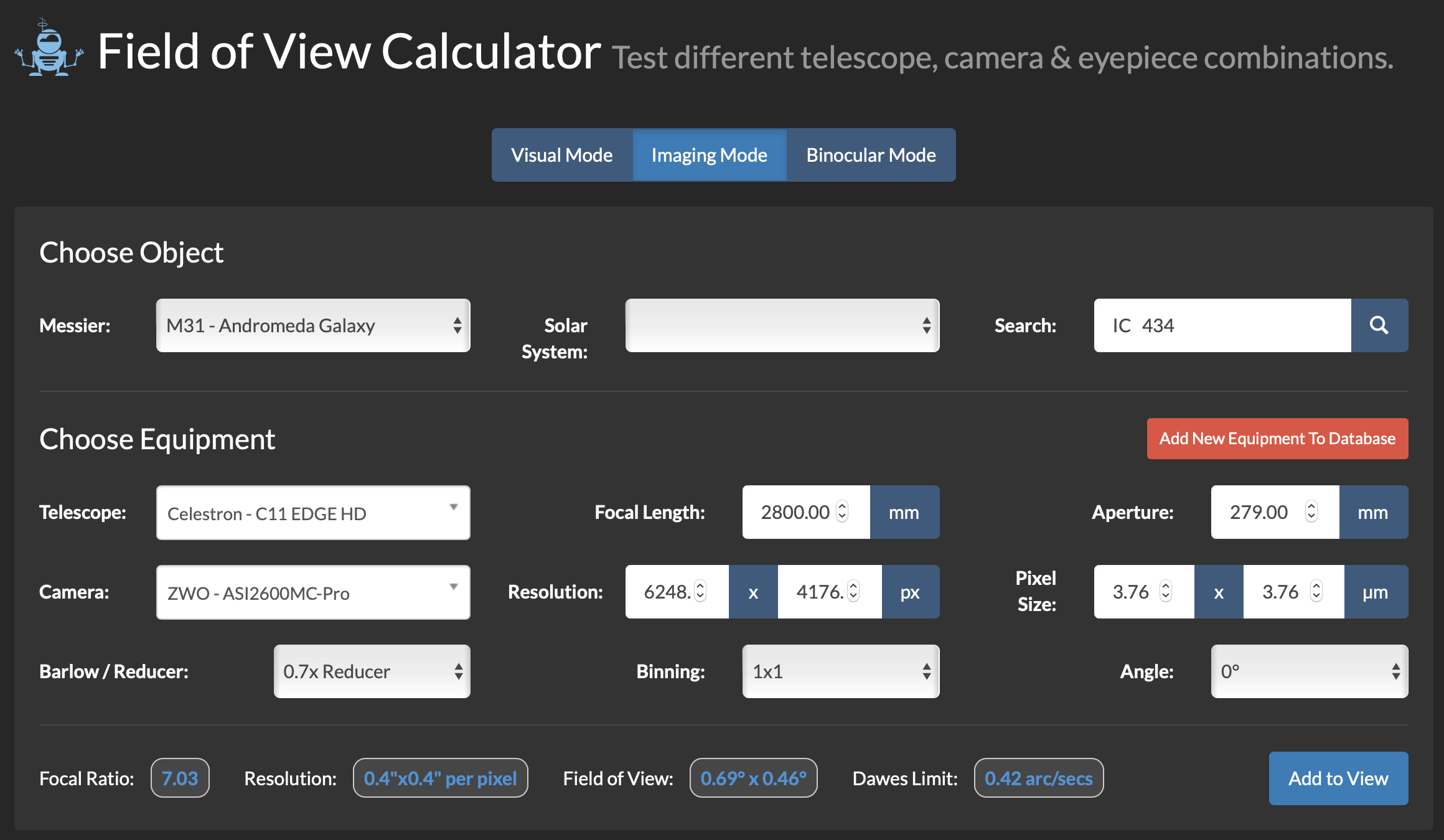The field of view (FOV) for all the imaging telescopes I own.
Your field of view (FOV) is the view your telescope has of the star field in the night sky. Telescope and camera selection has an effect on your FOV and in turn the size of object that’s suited for imaging with that combination. In the example above, I have 5 of my telescopes paired with a single camera, the ZWO ASI2600 MC-Pro. You can see how using the single camera with the different focal length telescopes has an effect on the size of the imaging area.
At the widest FOV you have the William Optics RedCat 51 telescope, and at the narrowest FOV you have the Celestron EdgeHD 11” telescope. The Edge scope is going to image an area that is much smaller, or more zoomed in, while the RedCat is going to image a much wider field. For this target of M31 (the Andromeda Galaxy), the Edge is only going to capture a portion of the galaxy, while the RedCat is going to capture an area much larger than the galaxy. But, it looks like my Astro-Tech AT60ED is just right for the job.
This scope provides the perfect framing for Andromeda.
How to use Astronomy.tools to try out image and camera combinations
I use the website Astronomy.tools to check my equipment combinations during object selection to find the most suitable telescope and camera for the job.
The first thing you’ll want to do is select the Imaging Mode tab at the top of the page. This allows you to pick a telescope and camera combination. If you are in visual mode, you can test out eye piece and telescope combinations to see how large an object should appear visually when looking through the telescope with your eyes.
Secondly, pick a target you’re looking to image for the night. You can use the search or pick a common Messier or planetary object. Then proceed to choose your telescope and camera combination.
Then select add to view to see how the pairing looks on the selected object.
Now, lets see how camera sensor size has an effect on the available FOV. Since you’re “seeing” the object with the camera sensor, the size of sensor plays into how large your FOV would be with the selected telescope.
Here’e two cameras that I currently use. The ZWO ASI1600MM-C camera, and the Two ASI2600MC-Pro camera. The former is a mono camera, and the latter is a color camera. But, lets ignore that fact right now, and just look at the sensor sizes. The 1600 is a 4/3” sensor size, which is approximately 17.7mm X 13.4mm.
The ZWO ASI2600MC-Pro camera is an APSC sized sensor. So much larger at 23.5mm X 15.7mm.
So, lets see how these cameras work on a new target. I’ve picked a small galaxy, M51. In this example, I’m using the same exact telescope, the Celestron EdgeHD 11”, but pairing it with two different cameras. You can see, the 1600 camera provides better framing, as the 2600 is just a bit larger.
Finally, here’s one more example of a different target, using the same two cameras, but the GSO 8” Ritchey Chreiten telescope instead.
This example shows M81 and M82, Bodes Nebula and the Cigar Galaxy. This screenshot was taken in SkySafari 6 Pro, which also has FOV tools for all your telescope and camera combinations. Here we see that the ZWO ASI1600MM-C is a bit small with this scope, and I risk cutting off one of the galaxies. But if I go with the larger ZWO ASI2600MC-Pro camera, the sensor is large enough to cover both galaxies and leave a little room to spare.
This hobby can be complex. And camera telescope combinations add to that complexity. In addition, there’s another factor that I didn’t cover, which is a bit more advanced, and that’s how suitable the camera is for any given telescope. The quality of the telescope, the effective seeing (a measure of atmospheric turbulence), focal length, effective resolution of your telescope, and the camera’s pixel size all factor into what makes a specific camera better or worse for your imaging outcome. Fortunately, Astronomy.tools offers a CCD Suitability Calculator that helps you properly pair a camera with your telescope, and they provide a good overview of the reasoning behind picking the perfect camera for your gear.








